What exactly is 5-axis CNC machining?
In the simplest terms, 5-axis machining is the use of a CNC to move a part or cutting tool in five different axes simultaneously.
It is capable of machining very complex parts, which is why 5-axis machining is particularly popular in the aerospace industry. However, several factors contribute to the wider adoption of 5-axis machining.
▽Push the machine tool to "one-time processing completion" to shorten the delivery cycle and improve efficiency.
▽The cutting tool or table can be tilted to avoid interference, so that the geometry of the part can also be better processed.
▽Since the tool or table can be tilted, the best cutting position and constant chip load can be maintained, so the tool life is improved and the cycle time is reduced.
What are the axes of "5-axis"?
The main advantage of 5-axis simultaneous machining over 5-axis machining is speed, as the latter requires stopping and starting between each reorientation of the tool, whereas the former does not. However, the same results should be produced regardless of whether the "five axes" are used in linkage or in coordinates.
It is also worth noting that with 5-axis machining, the speed advantage comes with the need for more moving parts, which leads to more wear and tear, and a greater need for part collision detection. From a programming standpoint, this is one of the reasons why 5-axis simultaneous machining is more complex.













